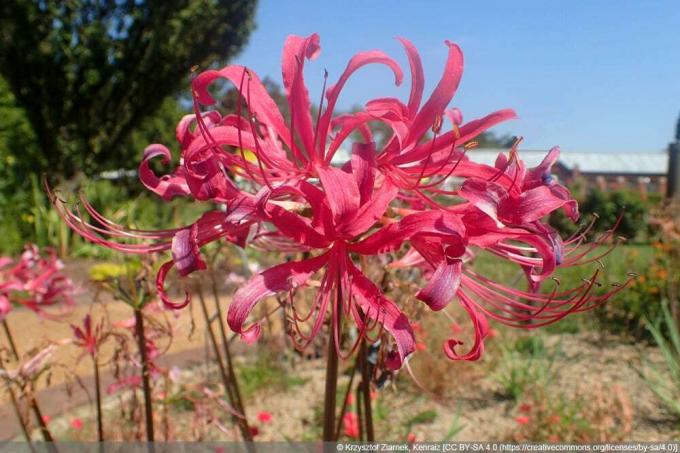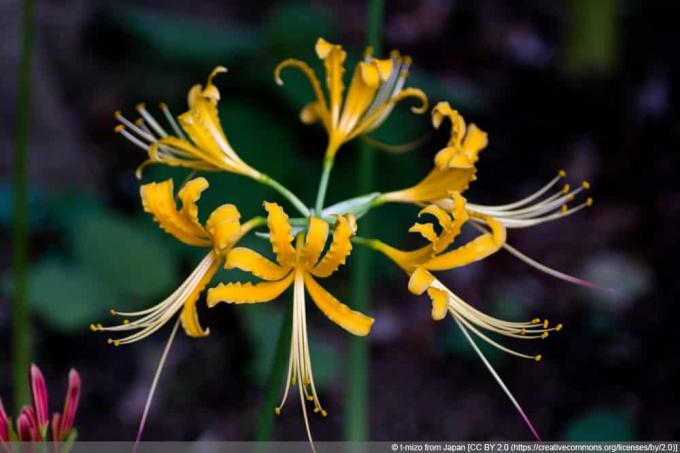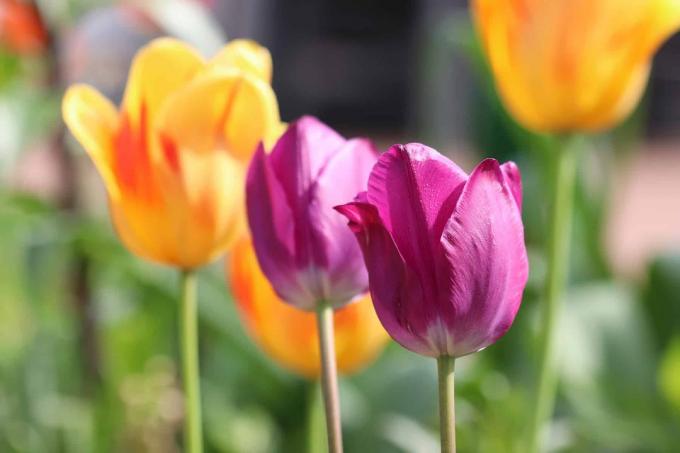

Table of contents
- particularities
- Location
- substrate
- Plant
- Care
- Pour
- Fertilize
- Cut
- multiply
- hibernate
- Overwinter in the bed
- Overwinter on the balcony or terrace
- hibernate inside
spider lilies, bot. Lycoris form a separate genus of plants in the Amaryllis family (Amaryllidaceae). There are currently 12 different species in the genus. The homeland of the plants is China and Japan, where they grow in the low mountains or on the edges of fields. Spider lilies should not be confused with the plant genus Hymenocallis is native to the American continent, but differs significantly from Lycoris in care differs.
particularities
A special feature of Lycoris is that it has a rest period in summer and in winter. So don't be surprised if the plants do not develop any flowers or leaves during the summer, because the first Flower stalks do not appear until late August and only after that do the leaves grow, which the spider lily uses during the winter serve as a nutrient supplier. In the coming summer, the plant loses its leaves until new ones are formed towards the end of summer.
Tip:
Depending on the species, Lycoris flowers in spring to early autumn. However, the plants do not flower regularly.
Location
Although spider lilies love the sun, direct sunlight in summer can cause burns. Since the plants do not tolerate temperatures of 27 degrees Celsius and more, they need a sunny location with some shade during midday. A semi-shady spot is recommended in southern locations. In regions with rather dry plants, Lycoris fits well in rock gardens or in sunny borders. In areas where damp summers are to be expected more frequently, spider lilies should not be planted out, but rather kept as potted plants.
Tip:
The location should be sheltered from the wind so that rain and wind do not break off the long umbels of flowers.
substrate
The optimal substrate for the spider lily is dry, loose, permeable and rich in humus. In the tub culture, the plant needs a mixture of:
- potting soil
- peat
- sand
If Lycoris is planted in the garden, the soil should be fresh and loose. You should also incorporate compost into the soil.
Plant

Spider lilies look best when planted in a group of at least three specimens. Therefore, especially in pot culture, it must be ensured that the pot is of sufficient size:
- planting distance: 10 to 15 centimeters
- planting depth: Plant the tip of the onion just below the surface of the soil
Spider lilies are planted in autumn. To do this, proceed as follows:
- loosen the soil
- Dig a planting hole
- Place the bulb in the planting hole with the tip pointing upwards
- Fill the planting hole with soil
- pour carefully
Tip:
In order to avoid waterlogging, you should create a drainage layer of broken clay and/or gravel in the tub culture at the bottom of the planter.
Care
The spider lilies are moderately demanding in terms of care. It is important that the plants are watered regularly so that the substrate does not dry out completely. Fertilizers supply the Asian beauty with important nutrients. And in winter, the plants must be protected from frost.
Pour
Spider lilies prefer dry soil. However, this does not mean that they can survive longer dry periods without watering. Therefore, you should water the plants regularly and make sure that they get enough water and that the soil is always slightly moist. It is best to water Lycoris when the top layer of soil has dried slightly.
Watering is reduced during the resting periods in summer and winter. However, the substrate must not dry out completely even during these times. The dormant phase begins when the leaves are completely withered.
Tip:
In container culture, you should reduce watering when the leaves begin to turn yellow.
Fertilize
The amount of fertilizer depends on the stage of the plant. According to the calendar, this results in the following times when fertilization takes place:
- after flowering until the full arrival of autumn, prefers potash fertilizers
- in early spring, prefers nitrogen fertilizers
- During the dormant periods in summer and winter there is no fertilization.
Tip:
Do not fertilize Lycoris immediately after planting, but wait about four weeks before applying the first fertilizer.
Cut
Since the leaves of the spider lily are valuable suppliers of nutrients for the plant during the dormant phase, they must not be removed. However, the flower stalk is cut off after the flowers have faded.
multiply
Spider lilies are propagated by division. Since a new onion bulb usually forms every year, this natural way can be used for propagation. The ideal time for division is in autumn after flowering. Once the onions have been harvested, they are placed in a pot with a mixture of sand, peat and potting compost, tip up. They spend the cold season there.
Tip:
Rooting in the young bulbs can take a year or two. It is therefore possible that the new spider lilies will not develop their first flowers until the third year.
hibernate
Spider lilies are only partially frost hardy. Depending on the variety, they tolerate sub-zero temperatures more or less well. Lycoris aurea, Lycoris radiata and Lycoris squamigera tolerate temperatures down to minus 15 degrees Celsius. However, you should keep the plants or protect the bulbs from frost.
Overwinter in the bed

Overwintering outdoors is basically possible, but there is a risk that Lycoris will not survive the German winter despite protection against frost and cold. The following measures are essential in any case:
- Cover the bed with brushwood and leaves
- alternatively a few layers of fleece cloth
Tip:
Prerequisite for overwintering in the bed is a highly water-permeable soil.
Overwinter on the balcony or terrace
If Lycoris is to overwinter on the balcony or terrace, then it needs a location that protects the plants from wind, cold, rain or snow, such as on a house wall. Because this gives off stored heat to the plants. In addition, the bulb and roots must be protected from the penetration of the cold:
- Cover the pot with a cold protection fleece
- Place the pot on a wooden board or a styrofoam plate against the cold from below
- Protect substrate from cold and wet from above
hibernate inside
If you want to be sure that cold and frost will not damage the spider lilies, you should overwinter the plants indoors. For potted plants, the winter quarters should have the following properties:
- Frost free
- bright
The outdoor season for potted plants begins when no more severe and persistent night frosts are to be expected.
 Home editorial office
Home editorial office
Learn more about flower bulbs

Tulips do not bloom and only put out leaves: what to do?
Tulips are among the most popular spring bloomers. They are therefore extremely common in domestic gardens. However, various causes can lead to the onion plants only developing leaves and no flowers. You can find out what to do in this case here.

Madonna lily, Lilium candidum: 9 care tips
Due to its growth height of more than one meter and the imposing white funnel-shaped flowers, the Madonna lily is one of the most impressive native bulbous plants. What to look out for when caring for this impressive flower is summarized in 9 clear care tips.

Daylilies, Hemerocallis: care from A – Z
Daylilies (Hemerocallis) are among the loveliest and most rewarding flowering perennials. Even if each individual blossom lasts only one day, countless new blossoms form again and again and decorate the garden for weeks. In addition, they are available in almost every color imaginable.

Freesia, Freesia: care tips from A - Z
Freesias are popular summer plants because they are colorful and have a pleasant, delicate scent. The irises, originally from Africa, are not difficult to care for, but do not tolerate frost. You can easily propagate the freesias yourself using the bulbs.

Milk Star, Ornithogalum: care from A to Z
The Orange Milk Star (Ornithogalum dubium) is a popular ornamental plant from the Cape Province. Because of its decorative flowers, it is often used as a cut flower in flower arrangements. The ornamental plants are undemanding, but should be cared for with caution due to their toxicity.

Checkered flower: care from A to Z | Instructions
The checkered flower (Fritillaria meleagris) attracts everyone's attention with its bell-shaped flowers. The reason for this is their striking pattern, which is strongly reminiscent of a chessboard. This striking check pattern shows the bulb flower in different shades.

